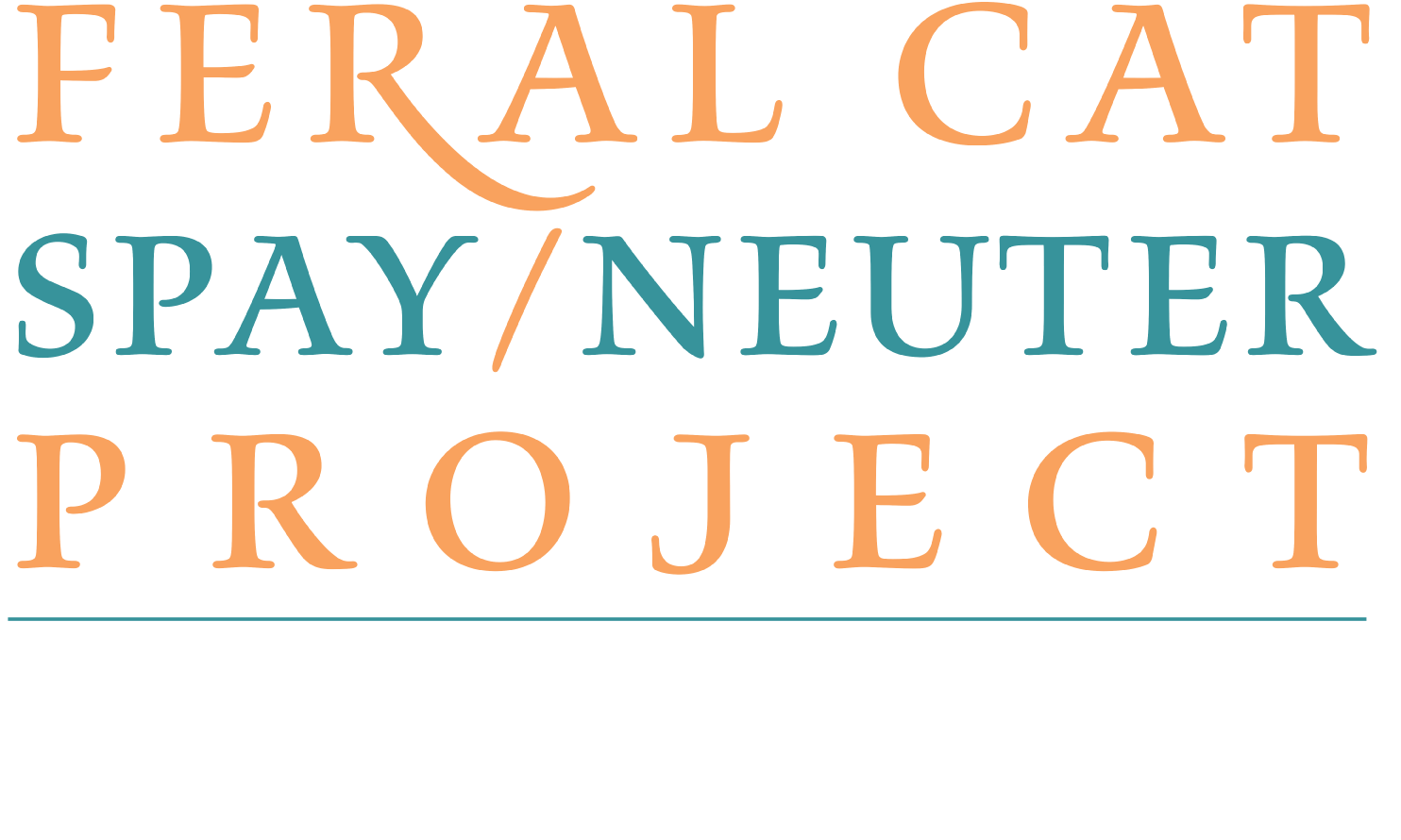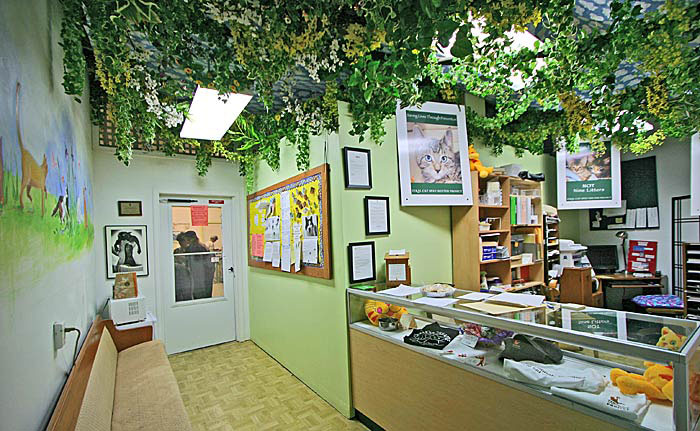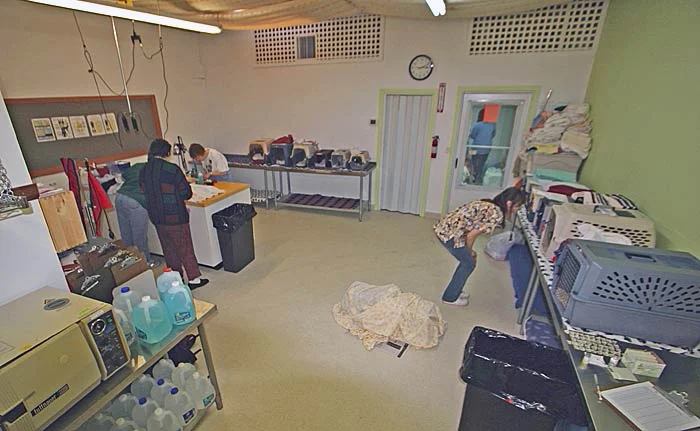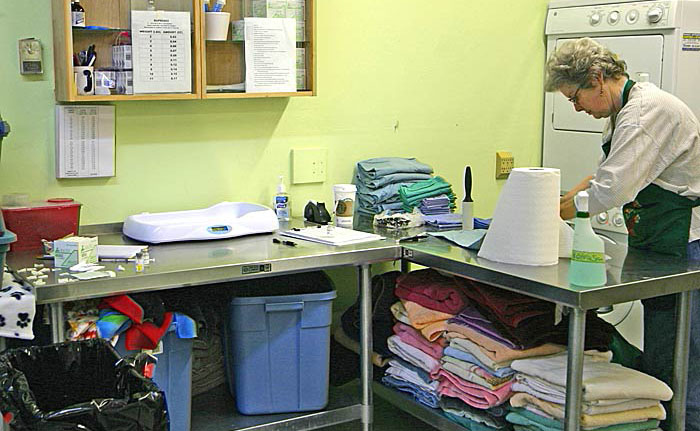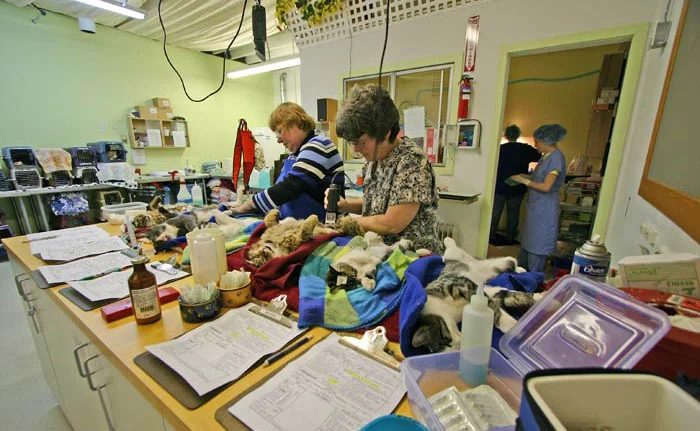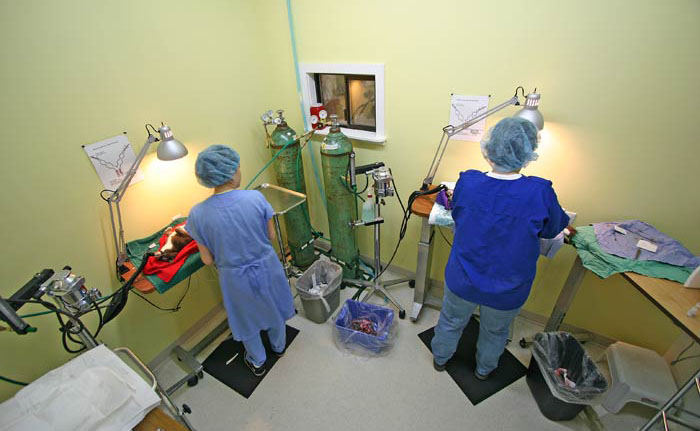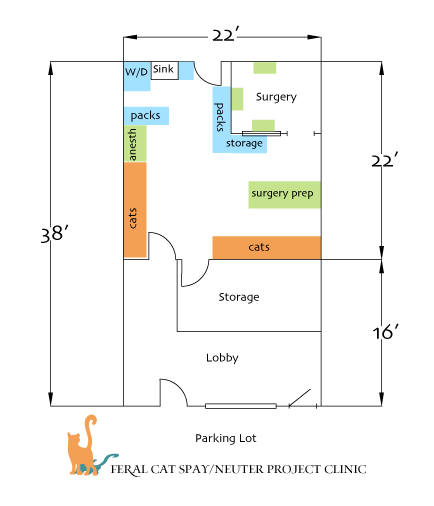How to Run Your Own
Clinic Overview
Our role as a National Mentoring Organization means that we invite other organizations to copy what we do. We want you to do more spays and neuters in an efficient, cost-effective and enjoyable way. The information in Our Clinic Model is designed to provide the unique information needed to replicate our successful high volume, high quality, spay/neuter clinic: The Feral Cat Spay/Neuter Project.
When seriously planning to open your own clinic, you must first meet several basic requirements:
- Establish non-profit status.
- Apply for business licenses.
- Create a successful financial plan.
- Create a successful human resources plan.
These requirements are vital but not unique to our clinic model. This type of general information is available from many resources. We have listed a few of these in our resource library.
Starting Ingredients
Congratulations! on your commitment to this invaluable contribution that you are preparing to make.
To create a high volume, high quality spay/neuter clinic, you must have:
- A focused, committed Board of Directors that believes in the goal.
- A strong, knowledgeable veterinarian to act as medical supervisor.
- Financial capacity to invest in start up equipment and supplies.
- A clearly defined mission and detailed scope of what services you plan to offer.
- Protocols and plans for clinic operations.
If you believe that your organization is ready, the next step is to secure:
- A clinic location to lease or purchase that is properly zoned for veterinary clinic use.
- A dedicated, talented veterinarian who is capable of performing high volume, high quality spay/neuter surgeries or who is willing to learn.
- A dedicated and talented support staff that is capable of committing to the workload, experienced in high volume, high quality spay/neuter or is willing to be trained.
- A volunteer pool from which to select or train reliable clinic volunteers.
Starting and running a high volume, high quality spay/neuter clinic is no small undertaking. The outcome of your hard work is immediately evident in the lives that you improve each day that you provide surgery. The rewards of providing a successful program are exponential compared to what you invest in time and energy.
Tour the Clinic
Staffing Overview
HISTORICAL EVOLUTION OF STAFF CONFIGURATION
Understanding our evolution may help you design a way to expand your current program.
In The Beginning...
- Monthly MASH-type clinics.
- All volunteer support (40-60).
- All volunteer veterinarians (6-8).
- Performed 150 surgeries over 10-hour days.
Warm Fuzzy Feeling Wore Off...
Began paying a few veterinarians on an hourly basis in order to maintain a full complement of surgeons each month. Many vets continued to volunteer.
Our Own Clinic: One Clinic Per Week...
- Employed one surgeon committed to one day per week.
- Hired one part-time veterinary technician.
- Two to three clinic volunteers.
- Fifty surgeries over 6-8 hours from Check-in to Check-out.
Our Own Clinic: Four Clinics Per Week...
- One full-time veterinarian.
- One full time Clinic Director.
- One full time veterinary technician.
- Two well-trained volunteers or four less-experienced volunteers.
Current Configuration: Four Clinics/Week, Transportation Clinics, + Mentorship Clinics
- One part-time Veterinarian
- One part-time Medical Director
- One full-time Clinic Manager
- Two full-time Clinic Technicians
- Four well-trained volunteers
The perfect world is the perfect number of perfectly skilled people working perfectly together. Cultivating the ideal volunteers requires time, patience and some luck. We currently have several teams of amazing volunteers who make our success possible.
Read our Tips for Clinic Team-Building for insight on what works long-term.
Reservations
Every organization meets the same challenge of managing reservations to fill the clinic with the perfect number of spays and neuters each day. Yet, when dealing with the unpredictability of trapping and the unknown genders, there is no magic formula to achieve this.
OUR CURRENT RESERVATIONS PROTOCOL
The three major highlights are:
- No reservations limit
- Stand-by slots on clinic day
- Ear tip cats receive priority on clinic day regardless of reservation status
This protocol began January 1, 2007 and holds to this day!
We prioritize ear tip cats over no ear tip cats at Public Clinics, regardless of reservations. For example, a no ear tip kitten with a reservation may be bumped to another clinic day for an ear tip cat that is Stand By. This not only increases access to surgery for free-roaming cats but also provides an option for a last minute trapping success with no reservations.
PRIVATE AND PUBLIC CLINICS
The reservations process is different for the two types of clinics that we offer, Private and Public. One benefit of allowing no ear tip cats at Public Clinics is decreased unpredictability. The uncertainty of trapping success is eliminated plus gender is usually known. For more information, read Using Public and Private Clinics and Managing Public Reservations.
WEB-BASED RESERVATIONS
With the launch of our new website, and Clinic HQ, reservations via this system are new to us.
The web-based reservations system accepts 40 reservations each day and up to 20 of these reservations are open to female cats. There are 10 standby slots open "day of" at each public clinic. The goal is to have 25 spays and 25 neuters per clinic day. The number of cats that show up remains unpredictable, because trapping success will always be unpredictable.
For the history of how we got to our current reservations protocol, read Evolution of the Reservations Process.
“Collaboration: To work jointly on an activity, especially to produce something.”
Collaboration Basics
Partnering with other organizations increases surgeries and builds relationships.
We provide a unique opportunity with private clinics:
- A full day of surgery: Allows for greatest efficiency of 50 cats in one day.
- Advanced, secure reservations: Provides time to schedule cats and volunteers.
- Financially accessible: Allows donations to stretch further.
Partnering organizations:
- Organize 50 reservations to fill the clinic.
- Coordinate transportation of cats to and from the clinic.
- Obtain surgical release forms and other required paperwork.
- Provide funding to cover clinic costs.
A few less-typical partners fund surgeries for organizations that can do the legwork but lack funding. Collaborations succeed when participants do what they do best, and everyone shares the workload along with the rewards.
Working together, we save even more lives.
Feral Cat Prevention Program
THE ORIGIN OF HOMELESS CATS
Unaltered, tame cats are the original source of all reproducing, free-roaming, homeless cats. If today we magically altered every feral-behaving cat, we would still have new kittens tomorrow. Litters from unaltered pet cats would become the feral-behaving cats of tomorrow. Feline homelessness cannot be solved without increasing spay/neuter of all cats, homed and homeless, feral-behaving, social and all those in between.
HUGE HIDDEN SOURCE OF KITTENS
Unaltered pet cats come from many sources: shelters, pet stores, newspaper ads, friends, strays and neighbors. There is another large, yet hidden source of unaltered kittens in our region, and in your region, too. How did we find it?
Being in our own clinic led to more contact with trappers. We repeatedly heard about the many litters of kittens gathered from cats that they trapped. Most caretakers foster and adopt out kittens. We slowly realized that literally thousands of unaltered kittens were being adopted out each year by grassroots rescuers. The impact of this situation is huge: each year, thousands of kittens not being altered before adoption.
MORE KITTENS THAN PET STORES
Realizing that grassroots rescuers handle many more unaltered kittens than local pet stores, we also realized, ironically, that grassroots rescuers are a huge hidden source of potential breeding cats. To plug this source of unaltered kittens, the concept of the Feral Cat Prevention Program was born.
ALTER BEFORE ADOPTION
Two serendipitous events launched us into offering surgeries without ear tipping, what quickly became our Feral Cat Prevention Program. One hurdle to starting the FCPP was poor acceptance of early-age spay/neuter. In time, we convinced rescuers that early-age spay/neuter is a safe, humane procedure used for decades in many progressive countries. Today, pediatric spay neuter is a widely accepted, safe, successful and well documented practice.
Now we educate everyone that ending homelessness begins with prevention through spay/neuter. For rescuers to prevent the onslaught of kittens into their homes next year, they must spay/neuter their rescued kittens this year.
AFFORDABLE ACCESS
Because we are emphatic about altering before adoption, we make spay/neuter financially accessible to all rescuers, particularly the “grassroots” rescuers. Donations generated by these surgeries are immediately directed into free surgeries for free-roaming cats. Our formerly reluctant rescuers are now huge fans of early-age spay/neuter.
NON-PROFIT ORGANIZATIONS USING OUR SERVICES: RESCUE GROUPS
Many non-profit organizations have used our free services and directed their donations into other parts of their programs. Over time, we realized that FCSNP was basically raising money to pay for their surgeries. After considerable discussion by the Board of Directors, we decided to request payment to cover surgery costs from any large organization legally authorized to fundraise, e.g., any 501©3 organization with gross receipts over $500,000/year .
